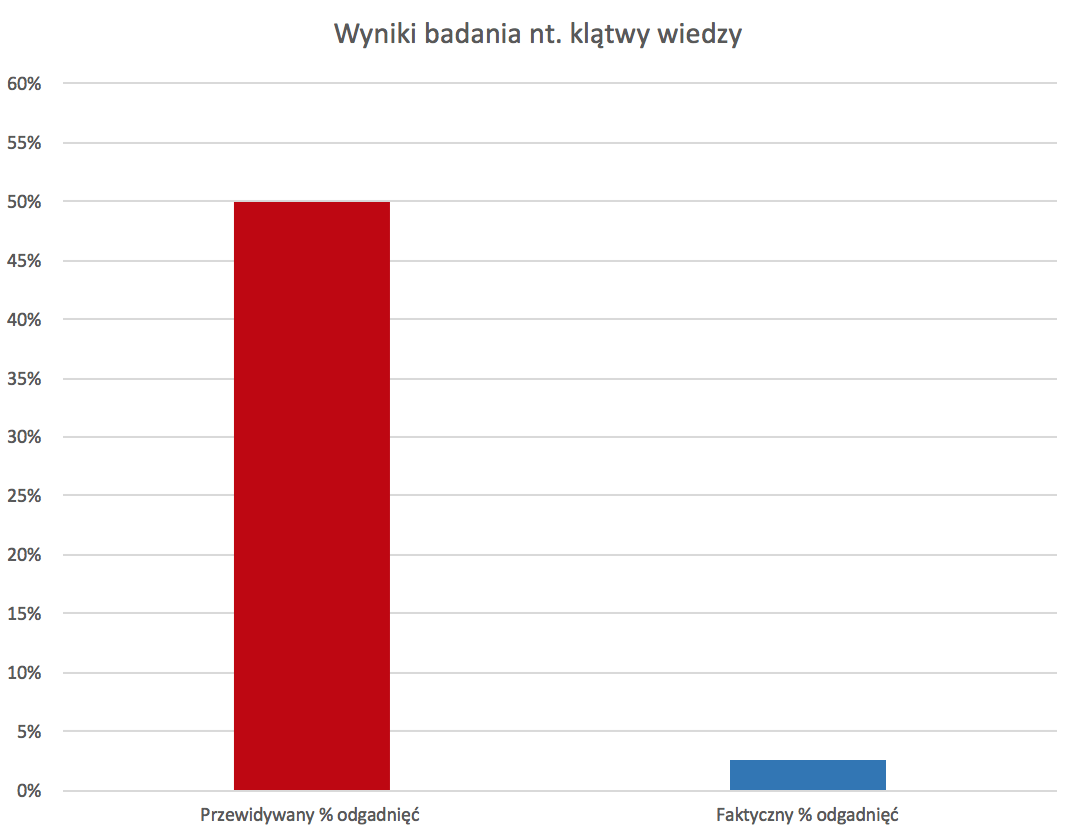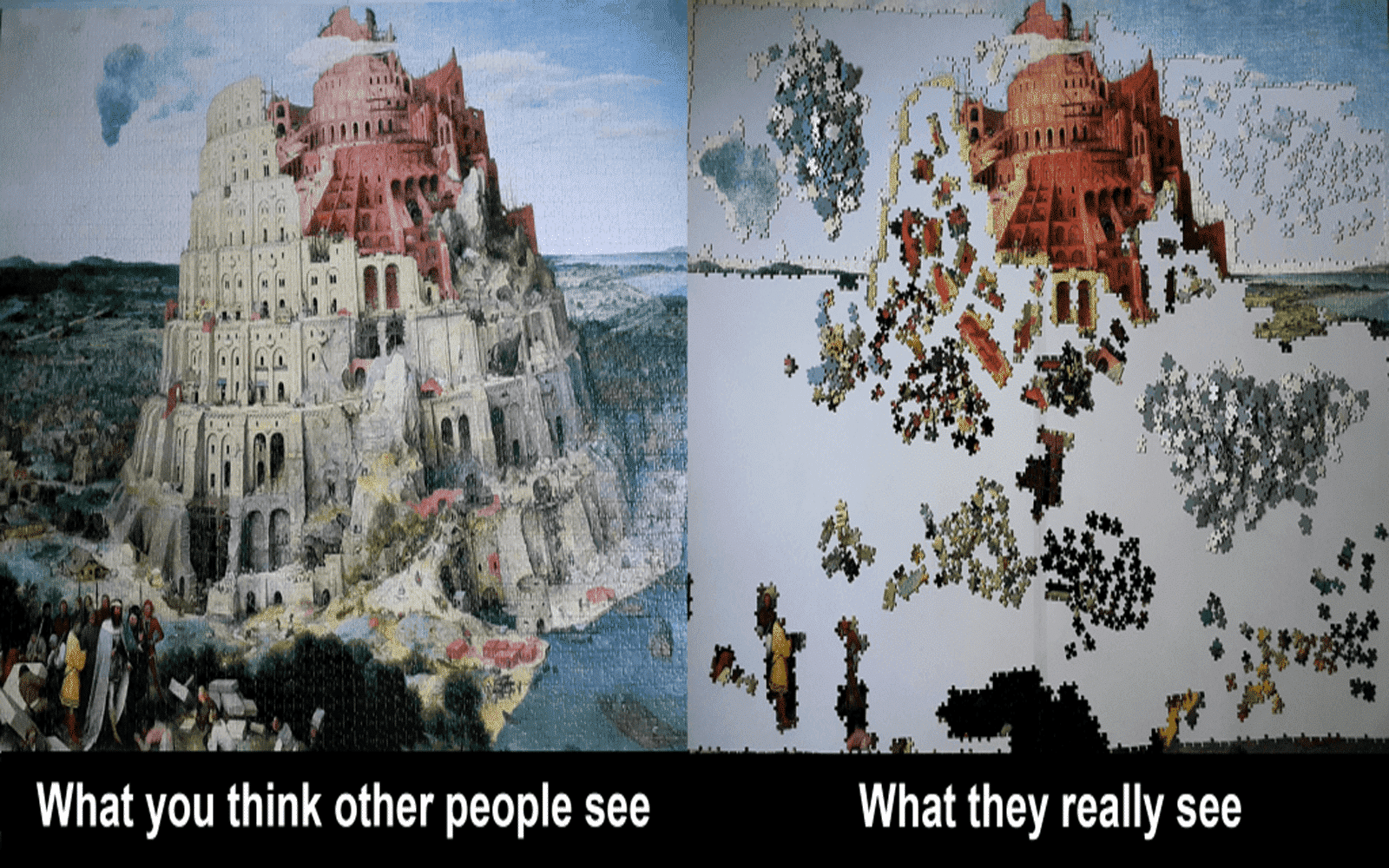Na czym ono polega?
Najlepiej tłumaczy to znane badanie Elizabeth Newton – studentki psychologii z Uniwersytetu Stanforda. [1]
Badanie obrazujące klątwę wiedzy
W 1990r. młoda studentka psychologii stworzyła prostą grę, przypominającą program “Jaka to Melodia?”. W ramach eksperymentu podzieliła ludzi na dwie grupy.
Członkowie grupy A: Wybierali utwór z 25 powszechnie znanych tytułów takich jak np. “Happy Birthday”. Następnie siadali przy stole i odgrywali piosenkę, stukając palcami o blat. Po wystukiwaniu oceniali jaka jest szansa na to, że słuchający z grupy B odgadną tytuł wybranej przez nich piosenki.
Członkowie grupy B: Siedzieli przy wspomnianym stole razem z członkami grupy A i wysłuchiwali w ciszy wystukiwanego utworu. Ich zadaniem było zgadnąć nazwę utworu.
Według stukających członków grupy A, Grupa B miała 50% szans na odgadnięcie o jaki utwór chodzi.
Wyniki badania
W rzeczywistości wyniki wyglądały zupełnie inaczej.
Grupa B, słuchająca wystukiwanego rytmu, podawała poprawną nazwę utworu w 2.5% przypadków. Innymi słowy, udawało się to w co czterdziestym przypadku. A nie jak przewidywali stukający z grupy A – w co drugim.
Z początku badaczom wydawało się, że może mieć to związek z przeświadczeniem stukających o ich świetnych zdolnościach odtwarzania muzyki. Dlatego stworzono drugą wersję badania. W tym wypadku bezstronnym obserwatorom podawana nazwę utworu i proszono ich o oszacowanie prawdopodobieństwa jej odgadnięcia.
Jak się okazało oni również ocenili szanse na odgadnięcie na 50%.

Odpowiedź na pytanie, co jest przyczyną takiego przeszacowania przyniósł wywiad z badanymi. Zarówno stukający jak i bezstronni obserwatorzy opisywali jak podczas wykonywania utworu wyraźnie słyszeli w głowie odgrywaną piosenkę. Towarzyszył im głos wokalisty, melodia oraz wszystkie instrumenty. *
*Tak jak prawdopodobnie będą towarzyszyć i Tobie, gdy pomyślisz o piosence “Final Countdown”.
Dlatego też stukający i obserwatorzy byli zdumieni, gdy członkowie grupy B nie mogli zgadnąć tytułu. Nie umieli wejść w perspektywę grupy B, która słyszała tylko nieregularne stukanie.
Z tego względu opisane zjawisko nazywa się klątwą wiedzy.
Na czym dokładnie polega klątwa wiedzy
Mówiąc prosto:
Gdy wiedza na jakiś temat jest dla nas łatwo dostępna, możemy odnosić mylne wrażenie, że dla innych też.
Czasami dotyczy to tak prozaicznych spraw jak tytuł nuconej piosenki. Często jednak konsekwencje są dużo mniej poważne – odnosimy wrażenie, że ktoś nie dostrzega naszego złego nastroju; sprzedawca zasypuje nas profesjonalnymi terminami, których nie rozumiemy; pracownicy nie mają pojęcia na czym polega strategia firmy.
Przez klątwę wiedzy nieświadomie zakładamy że nasz odbiorca wie na dany temat tyle samo, co my. Prowadzi to do nieporozumień i konfliktów. W organizacjach klątwa wiedzy często objawia się w komunikacji między działami oraz na linii menadżer-pracownik. W końcu skoro coś “wiadomo”, to po co to tłumaczyć?
Klątwa wiedzy często prowadzi do zabawnego przerzucania odpowiedzialności

Jak obejść klątwę wiedzy
Nie jesteśmy jednak wobec tego efektu bezbronni. Ciekawe sposoby na ominięcie klątwy wiedzy w organizacji opisuje Chip Heath – profesor Stanford Graduate School of Business.
W swoim artykule z Harvard Business Review [2] pokazuje jak przełożenie strategii firmy na konkretne przykłady pomaga ją efektywnie wdrożyć. Dzięki temu pracownicy lepiej rozumieją założenia zarządu, a klienci – wizerunek, który marka chce przekazać.
Strategia według Trader’s Joe
Pierwszy opisywany case dotyczy firmy Trader’s Joe – lidera amerykańskiego rynku w obszarze sprzedaży żywności świeżej i organicznej.
Już sama misja firmy jest dużo bardziej konkretna niż większość korporacyjnych haseł. Brzmi ona następująco: “Dostarczać naszym klientom najlepsze jedzenie oraz napoje, jak również informacje, aby mogli podejmować świadome decyzje zakupowe”.
Mimo to nie jest to hasło zapadające w pamięć.
Dlatego przetłumaczyli je na bardziej zrozumiały język. Wewnątrz organizacji Trader’s Joe znane jest pod hasłem “Home of cheap thrills”. W wolnym tłumaczeniu oznacza to “Miejsce w którym znajdziesz ekscytujące doznania”(w tym wypadku spożywcze).
Klient docelowy z kolei opisany jest jako profesor collegu jeżdżący bardzo starym Volvo.
Choć oczywiście prawdopodobnie niewielu profesorów collegu robi zakupy w Trader’s Joe, to taki przykład lepiej trafia do wyobraźni ludzi w organizacji. A na pewno lepiej niż „Mężczyzna, 50-65 lat, wykształcenie wyższe, zarobki do 4000 $/mies. lub brak, posiadający samochód, zainteresowania – nauka, czytanie książek i wędkarstwo”.
Dzięki temu to co wydaje się być oczywiste dla marketingowca, staje się też zrozumiałe dla innych pracowników. Mimo że tego rodzaju przykład stanowi znaczące uproszczenie, większości osób spoza marketingu całkowicie wystarcza.
Przekazywane informacje, przykłady i historie są jak puzzle, z których odbiorca układa obraz omawianej kwestii. Jeżeli nie zostaną podane mu w odpowiedni sposób, obraz który stworzy będzie niekompletny. [Obrazki wzięte z PuzzleForum.pl].

Storytelling według FedEx’a
Innym sposobem na obejście klątwy wiedzy są historie. O tym jak wykorzystać storytelling w sprzedaży dowiadujemy się na przykładzie FedEx.
Sprzedawcy FedExa mają wiele case’ów pod ręką, ale jedna z historii jest szczególnie znana.
Nowy Jork, wieczór. Samochód dostawczy FedExu jedzie przez miasto, dowożąc ostatnie paczki tego dnia. Nagle van staje. Silnik przestał reagować. Siedząca za kierownicą kobieta szybko dzwoni po samochód zastępczy, jednak tamten utyka w korku.
Kierowca decyduje się przejść kilka nowojorskich przecznic i dostarczyć parę paczek pieszo. Niestety czuje że nie wyrobi się ze wszystkim na czas. Wtedy nagle widzi jak obok przejeżdża samochód dostawczy konkurencji. Zaczyna do niego machać, zatrzymuje go i przekonuje kierowcę, aby zawiózł ją do kilku ostatnich lokalizacji.Paczki docierają na czas.
Tego rodzaju historia, opowiedziana w ciągu dwóch minut, wyraziście pokazuje klientom, co oznacza (nomen omen) dowożenie. Często o wiele skuteczniej niż dziesiątki tabelek i wykresów. Wiarygodność dodatkowo buduje fakt, że FedEx organizuje konkurs w którym nagradza tego typu czyny słynną Purple Promise Award.
Opowieści zapadają w pamięć również pracownikom i stają się swego rodzaju firmową legendą. Wykorzystuje się je do edukacji nowych kurierów nt. wartości wyznawanych przez firmę.
Jak więc odczarować klątwę wiedzy i wykorzystać siłę czytelnych przykładów i historii w swojej komunikacji?
Storytelling, klątwa wiedzy i explainer video
Aby zrobić to skutecznie, musimy zadbać o kilka kluczowych punktów.
Wśród nich są:
spojrzenie na znany temat świeżym okiem,
- ujęcie go w prostych słowach,
- wybranie plastycznych, namacalnych przykładów do naszej wypowiedzi,
- oraz storytelling.
W proces najlepiej zaangażować osoby spoza naszej działki. Jeżeli ktoś nieznający tematu zrozumie o co nam chodzi, to znaczy że jest dobrze. Jeżeli do tego zapamięta czym się zajmujemy, jeszcze lepiej. Świetnie będzie, gdy całość zacznie go szczerze fascynować. A to się uda tylko wtedy, gdy zamiast głuchego stukania w stół, usłyszy całą melodię.
Przygotowania bardzo szybko spłacają się w postaci lepszego zrozumienia strategii firmy, płynniejszej komunikacji w zespole oraz skuteczniejszej sprzedaży. Nie mówiąc o klientach, którzy wreszcie, rozumiejąc nasz produkt, mogą pałać do niego równie dużym entuzjazmem, co my.
Przykład (sprzed 5 lat) jak w niecałą minutę zapoznawaliśmy klientów z nową usługą:
Jeżeli interesuje Cię, jakie jeszcze mamy sposoby na uniknięcie klątwy wiedzy pracując przy projektach, i chcesz dowiedzieć się, czy możemy Ci pomóc, zapraszamy do kontaktu.
Odpisujemy na maile najcześćiej tego samego dnia.

Psychologii uczył się na Uniwersytecie Warszawskim, biznesu na Szkole Głównej Handlowej i Uniwersytecie Cambridge. Podczas studiów psychologicznych badał to, jak ludzie radzą sobie, gdy są przytłoczeni zbyt dużą ilością informacji. To zainspirowało go do budowania przekazów, które tłumaczą złożone rzeczy w prosty sposób. W ramach ExplainVisually realizował projekty dla takich firm jak IKEA, Carlsberg, Orange, Pfizer czy TAURON. Ogromny fan podejścia naukowego, rzetelności oraz budowy marketingu i sprzedaży na solidnych podstawach.
